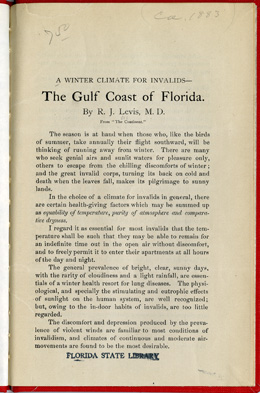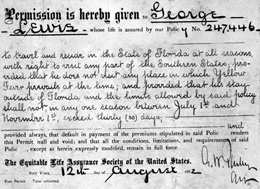Pestilence, Potions, and Persistence Early Florida Medicine
Healthy Climes and Killer Swamps
Doctors, Resorts, and Tonics
Doctors and resorts promoted Florida as a healthy destination for "consumptive invalids, for the nervous and debilitated, and for valetudinarians of all degrees." Florida's virtues included a combination of germ-free air, sea bathing, and the availability of fresh vegetables and meat.
Meanwhile, advertisements described their tonics as a safer alternative to vacationing in "an impenetrable swamp, full of snakes, alligators, turtles, and strange reptiles" where health seekers find that "Hope departs, and they either return home to linger out the brief remainder of their miserable existence, or die among strangers."
Bethesda
This advertisement for a health tonic, Nichols’ Bark and Iron, was published in 1885. It gives vivid descriptions of places in Florida and around the country renowned for their healthful climates, only to critically argue that each has its drawbacks and that use of a health tonic can be just as therapeutic.
Dedicated to the “mechanic, the farmer, and the tradesman, as well as the professional man,” the book provided descriptions of the health vacations unattainable to most working people at the time, while assuring them that good health was attainable without such luxuries.
In addition to Atlantic City and camps and cities in Colorado and Montana, Florida locations specifically addressed include Jacksonville, St. Augustine, Green Cove Springs, and “Pilatka.” The pamphlet also contains prints depicting the St. Johns River and Silver Springs.
Winter Climate for Invalids
According to this piece from 1883 by R. J. Levis, M.D., the combination of warm air, dynamic winds, ozone-producing electricity in the atmosphere, and availability of fresh vegetables and meat made Florida a particularly good location for individuals suffering from a variety of ailments.
While the resorts most often visited were along the course of the St. Johns River, the writer believed that the rapid expansion of railway travel and development along more of the coasts would open up Florida lands even better suited for invalids.
He noted that areas of Florida were already popular for “consumptive invalids, for the nervous and debilitated, and for valetudinarians of all degrees.”
He also believed that sea baths and warm and surprisingly dry air were beneficial for sufferers of other conditions such as tuberculosis.
The publication came at a time when Florida was beginning to undergo much greater development of areas farther down the peninsula, and when tourist destinations began more aggressive promotion of the beauty of the Florida landscape.
The small essay, excerpted from the illustrated weekly, The Continent, includes statistics comparing the temperature, precipitation, and humidity of Florida cities with cities in the northeast and midwest.
Dr. Levis was particularly impressed by the climatological conditions of Punta Rassa and the southern Gulf Coast of Florida. This region, heretofore less popular than the east coast as a location for health resorts, was also just about to become much more accessible because of increased train and ship access, and the city of Punta Rassa was a cattle boom town, becoming more popular with sport fishing tourists.
The work demonstrates the importance of the idea of Florida as a place offering healthful relaxation and escape as the state sought to expand its development and population.
Permission to Travel
In this proof of insurance from 1882, the policy holder is covered for travel and residence in Florida, provided he does not travel to areas currently infected with yellow fever. Even as the state began to grow and expand economically, and certain areas had already gained reputations as health resorts, the possibility of illness resulting from travel there warranted special insurance coverage.

 Listen: The Latin Program
Listen: The Latin Program


